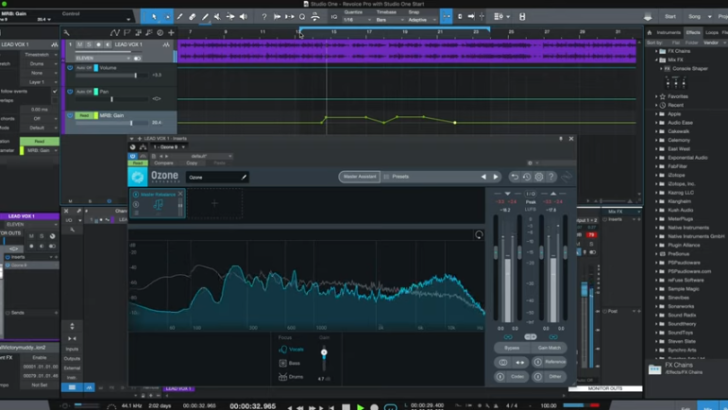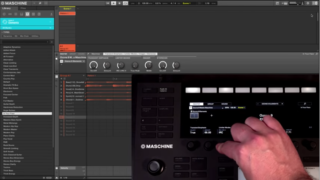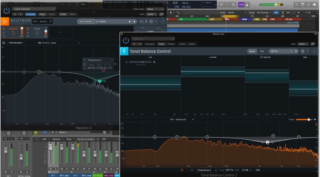Today, iZotope launched Ozone 9, the newest update to its audio mastering system. Ozone 9 “brings balance to music” with new processing for low end, new real-time instrument separation, and fast workflows powered by machine learning.
New Ozone 9 features include an expanded Master Assistant, Tonal Balance Control can now talk to more iZotope plug-ins in the session, and plug-in performance is improved for faster work, smoother metering, and resizable windows, among other features.
Ozone 9 Key Features:
Master Rebalance: Adjust the levels of vocals and other instruments in a stereo audio file, solve balance issues without needing the original stems.
Low End Focus: Quickly adjust the contrast and definition of low frequencies for a “hard hitting master every time,” without need for a more complicated plug-in chain.
Improved Tonal Balance Control: Tonal Balance Control is improved with smoother metering, resizability, new target curves, and inter-plugin communication with Relay and Nectar for gain control across the mixing and mastering stages.
Expanded Master Assistant: Choose from a modern or vintage vibe, with loudness targets for CD and streaming.
Match EQ module: Ozone 9 offers a new experience for Match EQ, with a better preset workflow, the ability to match from a reference track, and deeper controls that let users match parts of the frequency spectrum.
Vintage Modules: A collection of Vintage modules add “warmth, grit, and vibe” to a creator’s music, now in Ozone 9 Standard.
Updated UI/UX: Ozone 9 is faster and easier to use, with a modernized resizable interface, fluid metering, and an expanded module chain.
Native Instruments NKS Support: NKS support puts Ozone into the creative production process. Access controls, presets and DSP from within an NKS-supported environment, such as MASCHINE or a KOMPLETE KONTROL keyboard.
Improved Performance: Experience faster performance and smoother workflows, improved visualizations and fluid metering.
Component plug-ins: Use any Ozone 9 Advanced module as a separate plug-in in a DAW, meaning users get more than 10 component module plugins.
Here’s a more detailed look at what’s new in Ozone 9:
With the release, iZotope has also introduced Music Production Suite 3, giving access to over thirty industry-standard plug-ins that interact across the session and provide assistive features, new workflows, and “cutting-edge” visual analysis tools. It features the brand new Ozone 9, along with iZotope’s most musical stereo reverbs R4 and NIMBUS. Users will also take advantage of educational content with a one-year Groov3’s All-Access Pass.
iZotope’s Tonal Balance Bundle, which includes Neutron 3 now also includes Nectar, Ozone 9, and brings mixing and mastering into one interconnected workflow.
Pricing and Availability. iZotope Ozone 9 is now available. Pricing options are as follows:
- Ozone 9 Advanced ($499 MSRP)
- Ozone 9 Standard ($249 MSRP)
- Ozone 9 Elements ($129 MSRP)
- Also included in Music Production Suite 3 ($999 MSRP) and Tonal Balance Bundle ($699 MSRP)
More information about iZotope Ozone 9, product specifications and features and system requirements, is available on the iZotope website.






Behringer already released Ozone 10 at a lower price point. This software is irrelevant.
Serious question. Who would buy this when Behringer’s mastering suite Fauxzone 9 comes out a decade from now after being announced yesterday?
I gotta say am really enjoying the Behringer snark, aftr the usual Uli worship that happens on these threads – seriously. Now to business, Izotope releases a new number each year which is starting to feel like a “subscription”, but I am pleased with the results, so fair enough!
I seriously don’t get this.
Ozone has made tons of great SW that empowers the user and puts the engineer and producer in control.
Now they release this and talk about “surgical precision” while giving the user one slider named “drums” another for “vocals” and one for “bass”.
From providing tools that could help a producer or mastering engineer to create the music of tomorrow, they provide presets so that all music can sound like yesterdays radio wash.
A slider for punch?
What exactly is the physical, mathematical or psychoacoustic definition of punch?
What definition is used by the SW?
Could you please give us controls that explains exactly what the SW is actually doing so that we may use these tools to our advantage and have the freedom to think out of the box?
Or has the world really come down to “Oh, I wanna make a pop song, so naturally I just pressed the ‘pop’ preset!”?
I guess the answer will be “you don’t need to know all of that stuff, we have thought about that so you don’t have to! Just believe in the results!”.
Well if the results is anything like the washy vocals and phassy mix in the demo I would say the results speak for themselves…
I wish they would give some love to the orchestral/hybrid community. They haven’t really given much direction or attention to helping out those working in that area. I suppose we’re just supposed to have more expertise in mastering orchestral stuff? Even some starting points for mastering presets for each section might be nice.